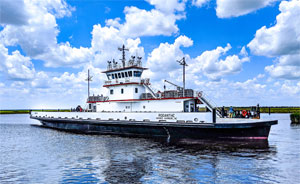On a blistering June day, a sizable crowd gathered in the shade of an outdoor shelter fronting the Hatteras Ferry Terminal on North Carolina’s Outer Banks. Ferries arrived and departed while a new ferry was being christened.
Rodanthe, named for the beach town 35 miles north of Hatteras, is the first new ferry to ply the Hatteras-Ocracoke Island route since 2006. Ferries on the route handle approximately 275,000 vehicles annually.
The 183-foot Rodanthe, a 40-vehicle, 300-passenger River-class ferry, will replace the 150-foot, 26-vehicle, 149-passenger Thomas A. Baum, a Hatteras-class vessel due for retirement sometime before 2021.
The North Carolina Department of Transportation (NCDOT) Ferry Division is the second largest in the U.S. behind Washington state. Four of its routes, including the Hatteras-Ocracoke run, are free, and state subsidies keep tolls low for the other three.
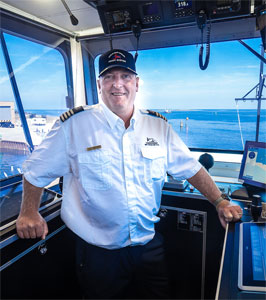 |
|
Capt. James Leland Groce stands amid the Furuno electronics array in Rodanthe’s pilothouse. Upgrades from older ferries in the fleet include hands-free communication. |
|
Brian Gauvin |
As the need for more vehicle and passenger capacity increases, NCDOT is gradually replacing seven Hatteras-class ferries with River-class ferries.
Constructed at Bollinger Shipyards in Amelia, La., Rodanthe is the eighth NCDOT ferry fitted with Voith Schneider propellers (VSP). Southport, the first ferry in the fleet equipped with cycloidal drive propulsion, was designed by Schuller & Allan and built at Steiner Shipyard in Bayou La Batre, Ala., in 1996.
Rodanthe, designed by Elliott Bay Design Group (EBDG), is the first in the fleet with cycloidal units constructed in the U.S. at Voith’s plant in York, Pa. It is the sixth ferry that Seattle-based EBDG has designed for North Carolina, including the larger Sound-class vessels Swan Quarter and Sea Level connecting Ocracoke Island with Swan Quarter on the mainland and Cedar Island.
“The main challenges with respect to Voith Schneider propellers are optimizing the hull to provide good flow conditions for the propellers and structural integration with the vessel,” said Mike Johnson, project engineer at EBDG.
“Voith has given us great service and reliability,” said Jed Dixon, deputy director of operations for North Carolina’s Ferry Division. “(VSP-equipped ferries) are highly maneuverable, especially in high wind, and it blows here all of the time. For half of the year, you’ve got over 20-knot winds.”
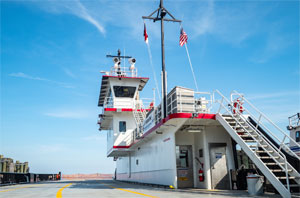 |
|
Rodanthe awaits its next run at the Hatteras Ferry Terminal. The River-class vessel can accommodate 40 vehicles and up to 300 passengers. |
|
Brian Gauvin |
Before Hurricane Sandy ripped up the Atlantic coast in 2012, the trip from Hatteras to Ocracoke Island took 40 minutes via a channel cutting through Pelican Shoal. The storm filled in the channel and scoured the tips of each land mass, widening the gap from a quarter of a mile to 2.5 miles between the south tip of Cape Hatteras to the north tip of Ocracoke Island. The trip now takes an hour.
The U.S. Army Corps of Engineers was called in to dredge the channel, but the expanded stretch of ocean surging through Hatteras Inlet refilled it in a matter of days.
The longer running time for the route increased the fuel and maintenance bill for the NCDOT while reducing the number of ferry trips per day from 52 to 38. The new reality exacerbated the already existing capacity issue.
“The motivation to build Rodanthe was to replace the 25-year-old ferry with one with more capacity to accommodate more cars and more people,” Dixon said. “And we are overhauling the fleet with (EPA) Tier 3 Cat C18 engines.”
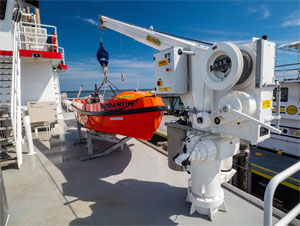 |
|
Emergency equipment on Rodanthe includes a Palfinger rescue boat deployed by a Palfinger hydraulic davit. |
|
Brian Gauvin |
Rodanthe is designed to be more seaworthy to keep water flowing under the bow instead of over it and spraying vehicles. Dixon cited the constant buildup of shoals as another challenge that needed to be addressed.
“These new boats have a shallower draft, 4.5 (feet) from 5.6, so the shallower draft gives us a little relief,” he said.
“NCDOT required a 4-foot, 6-inch draft vessel that could carry 40 cars in very shallow water, with enough speed to keep schedule,” Johnson said. He added that constraints regarding length and beam, dictated by the existing terminal dimensions, drove the design of Rodanthe.
“Significant effort, including CFD (computational fluid dynamics) and model testing at MARIN (Maritime Research Institute Netherlands), went into optimizing the hull to minimize the shallow-water effects,” Johnson said.
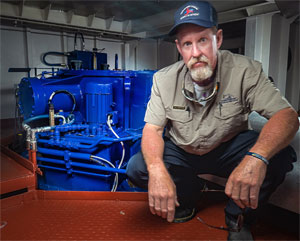 |
|
“The size of the engine room is impressive to me,” says chief engineer Clay Harris, shown with one of the new ferry’s VSP cycloidal drives. |
|
Brian Gauvin |
In addition to increased vehicle and passenger capacity, Rodanthe has several other built-in improvements over the older ferries — improvements that are especially appreciated in inclement weather. These include a deck-level passenger lounge, interior restrooms and new technology.
“I like the technology best,” said ferry master Capt. James Leland Groce. “Hands-free communication allows me to have (better) control of the vessel” when a dispatch is necessary. The public address system also now has recorded safety briefings and announcements, relieving the captain of that distraction while maneuvering at the terminals.
Another new feature is the fire suppression system that can be turned on at each fire station, eliminating the communications time lag created by having the system initiated from the bridge.
“The size of the engine room is impressive to me,” said chief engineer Clay Harris, a veteran of 29 years tending marine machinery. “It’s not as hot as a more cramped space, and there is plenty of room to work on each piece of equipment in there.”
The double-ended ferry has a 600-hp Caterpillar C18 main engine shafted to a Voith Schneider propeller fore and aft. The engines can operate independently in either direction, or together, one pulling and one pushing. The cycloidal units also can propel the ferry at 7 knots sideways.
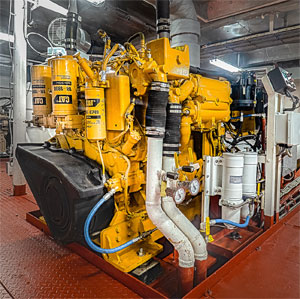 |
|
Each VSP drive is driven by a 600-hp Caterpillar C18 diesel. |
|
Brian Gauvin |
Elliott Bay has designed three additional ferries, currently under construction, for NCDOT. Progress on the 100-passenger Sound-class catamaran Ocracoke Express, under construction at U.S. Workboats in Hubert, N.C., has been hindered by delays at the shipyard.
The other two ferries are River-class vessels, but with diesel-electric propulsion and azimuthing stern drives. Tentatively named Avon and Salvo, they are under construction at Gulf Island Fabrication in Houma, La., and are scheduled for delivery in 2020.
Elliott Bay’s experience in designing z-drive ferries dates back to the 40-year-old Guemes, which is still carrying passengers and vehicles across Guemes Channel between Anacortes, Wash., and Guemes Island in Washington’s San Juan Islands.
Like VSP propulsion, z-drives provide enhanced maneuverability over a traditional propeller and rudder system, especially at low speeds and against crosswinds or crosscurrents, Johnson said.
“The added maneuverability is especially valuable for the ferry route between Hatteras and Ocracoke, which follows a narrow, winding channel that’s subject to shoaling and wind-driven currents,” he said.
 |
|
An aerial view of the ferry at its berth highlights its double-ended loading capability and four-lane vehicle deck. |
|
Courtesy NCDOT |
During the christening of Rodanthe, the passenger ferry Martha’s Vineyard Express — temporarily renamed Ocracoke Express — arrived at the terminal and berthed in the adjacent slip to prepare for its own “on the fly” christening. The NCDOT is leasing the vessel from the New Jersey-based ferry company Seastreak until the new Ocracoke Express is delivered from US Workboats.
Martha’s Vineyard Express carries up to 149 passengers per trip along the length of Ocracoke Island, directly to the south terminal at Ocracoke Village. By Aug. 5, 22,000 passengers had made the run since the ferry’s inaugural transit for the NCDOT on May 20.
Dixon said Rodanthe and Martha’s Vineyard Express are helping to alleviate the pressure caused by increased ridership and the reduced number of daily runs between Hatteras and Ocracoke.
“It’s a big step forward to modernize the fleet and also meet the new emission standards,” he said. “We will be building (more) new ferries based on funding.”

